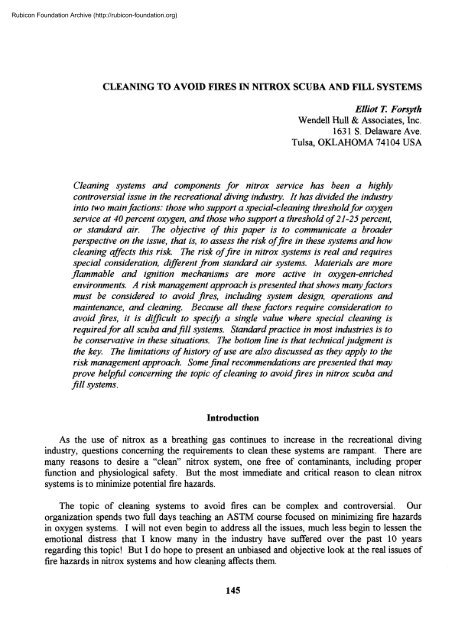Nitrox workshop dings - Divers Alert Network
Nitrox workshop dings - Divers Alert Network
Nitrox workshop dings - Divers Alert Network
Create successful ePaper yourself
Turn your PDF publications into a flip-book with our unique Google optimized e-Paper software.
Rubicon Foundation Archive (http://rubicon-foundation.org)CLEANING TO AVOID FIRES IN NITROX SCUBA AND FILL SYSTEMSElliot T. ForsythWendell Hull & Associates, Inc.1631 S. Delaware Ave.Tulsa, OKLAHOMA 74104 USACleaning systems and components for nitrox service has been a highlycontroversial issue in the recreational diving industry. It has divided the industryinto two main factions: those who support a special-cleaning threshold for oxygenservice at 40 percent oxygen, and those who support a threshold of 21-25 percent,or standard air. The objective of this paper is to communicate a broaderperspective on the issue, that is, to assess the risk of fire in these systems and howcleaning affects this risk. The risk of fire in nitrox systems is real and requiresspecial consideration, different from standard air systems. Materials are moreflammable and ignition mechanisms are more active in oxygen-enrichedenvironments. A risk management approach is presented that shows many factorsmust be considered to avoid fires, including system design, operations andmaintenance, and cleaning. Because all these factors require consideration toavoid fires, it is difficult to specify a single value where special cleaning isrequired for all scuba and fill systems. Standard practice in most industries is tobe conservative in these situations. The bottom line is that technical judgment isthe key. The limitations of history of use are also discussed as they apply to therisk management approach. Some final recommendations are presented that mayprove helpful concerning the topic of cleaning to avoid fires in nitrox scuba andfill systems.IntroductionAs the use of nitrox as a breathing gas continues to increase in the recreational divingindustry, questions concerning the requirements to clean these systems are rampant. There aremany reasons to desire a "clean" nitrox system, one free of contaminants, including properfunction and physiological safety. But the most immediate and critical reason to clean nitroxsystems is to minimize potential fire hazards.The topic of cleaning systems to avoid fires can be complex and controversial. Ourorganization spends two full days teaching an ASTM course focused on minimizing fire hazardsin oxygen systems. I will not even begin to address all the issues, much less begin to lessen theemotional distress that I know many in the industry have suffered over the past 10 yearsregarding this topic! But I do hope to present an unbiased and objective look at the real issues offire hazards in nitrox systems and how cleaning affects them.145
















